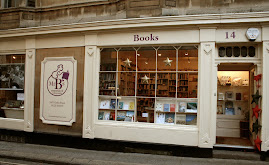The House by the Thames: and the People Who Lived There by Gillian Tindall
In my
 last post I promised that after reading The House By the Thames: and the People Who Lived There I would know all there is to know about the history of London. I feel that, although that was a slight oversight, I have definitely learnt a lot about 49 Bankside and that area through the ages.
last post I promised that after reading The House By the Thames: and the People Who Lived There I would know all there is to know about the history of London. I feel that, although that was a slight oversight, I have definitely learnt a lot about 49 Bankside and that area through the ages.49 Bankside and the small terrace of modest looking houses sits right up next to the millennium bridge, opposite St Paul's and in the shadow of the huge old power station which houses the Tate Modern. Having walked past those houses many times, I have long been curious about how they managed to survive and what kind of people live inside. The anecdotal history throughout this book is very interesting it explores the Tudor inn which once stood on the site, the boat men who carried passengers across the river to the theatres in Shakespeare's times and also the huge changes on Bankside at the time of the industrial revolution.
Sometimes in the past I have struggled to read non fiction; my love for novels springs from being able to immerse myself in a story and typically I did find some sections of this book more interesting than others. There is no denying that Tindall has done a brilliant job in creating a well written and accessible history and I wish I was as interested in the coal trade chapter as I was in the chapter describing the fire of 1666, but I am afraid that is probably more down to my short attention span than anything else.
I will feel inclined to bring my copy of The House by the Thames next time I am in that part of the city and use it as a sort of travel guide. There are definitely some particular anecdotes I think will stick in my head and others I would like to put in to context by giving Bankside a visit.
So, after my brief spell in the basement of the history section I decided to give myself a break back to fiction. With a novel which is also about a house....(drum roll)..
The Glass Room by Simon Mawer

I would like to start by saying that I loved this book. Much more than I thought I would after reading the first chapter, which I had to re-read having read the end. Set in Czechoslovakia in the late 1930s this novel revolves around the Landauer house: an innovative piece of modern architecture built for Liesel and Viktor Landauer by the architect Rainer before the gradual decline of their nation into war.
The novel is one about war, betrayal and attraction in a uniquely cold but beautiful setting. The glass house acts as a metaphor throughout the book- to begin with for the growth of the Landaur family and then, as the house passes hands from a laboratory for genetic experiments to a dance studio, for the cultural decline from decadence into war. The wholly believeable characters and the subtle way in which Mawer describes their precarious situation makes this a gripping, thought provoking read. Apparently the house in The Glass Room was based on a real historical landmark in former Czechoslovakia, which makes it even more fasinating for me. This is definitely a book that I would recommend and, although so far I have only read two, the best book I've read all year!
My next choice was made in a slight rush to avoid the prospect of a long train journey with nothing to read. I often find rash decisions are made in these circumstances but in this case I was sweetly surprised. I have gone from glass houses to glass..feet, strangely.
The Girl with Glass Feet by Ali Shaw
As the title suggest this book is about a girl whose feet are gradually turning into glass which she covers up with many layers of thick socks and some big policeman's boots. Set on a strange and in some ways magical small island, which we are led to believe, is somewhere in the very far

north.
The girl with glass feet, Ida, meets Midas a photographer come florist who is still coming to terms with his father's suicide and Henry Fuwa an obsessive science enthusiast who spends most of his day rearing mythical creatures which resemble tiny cows with wings. I really enjoyed both the lyrical fairytale descriptions and the subtle way in which Ida's transformation takes place. Even though the subject is obviously so fantastical the links with medicine and the modern day setting makes the glass feet thing almost matter of fact. The characters, too, are tragic but likable
and complex.
There are some beautiful parts to this novel which I really enjoyed and although I found the end chapters slightly over emotional for my tastes, (I don't want to say to much I case I give away spoilers!) This is an all round magical read once you ignore the cover which I think is way too girly and romantic.
I have already started my next read which, so far, I am very much enjoying. I will save that for
next time!



